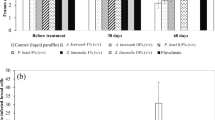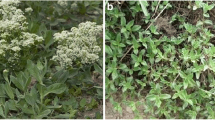Abstract
Varroa destructor is an external parasitic mite that is a serious pest of honeybees and has caused severe losses of colonies worldwide. One of the feasible alternative treatments being used for their control is essential oils. The aim of this work was to evaluate the bioactivity of some essential oils on V. destructor and Apis mellifera in relation with their chemical composition and physicochemical properties. Lavender, lavendin and laurel essential oils showed linalool as main compound in their composition. 1,8-Cineole was also present as a predominant component in the laurel essential oil. However, thyme oil was characterized by a high concentration of thymol. Mites and bees toxicity was tested by means of complete exposure method. For mites, LC50 values for laurel, lavender and lavendin essential oil did not show significant variation throughout all observation times. However, the LC50 values for thyme oil at 48 and 72 h were lower than at 24 h. Bee mortality was evident only in treatment with thyme oil. At 48 and 72 h, lavender essential oil presented better selectivity indexes. In this research, all essential oils caused mite mortality without severe harmful effects on adult bees. The simultaneous evaluation of the physicochemical analysis of the essential oils, the characterization of the dosage response relationships among them, and the mortality effects on mite and bees, give us the possibility to obtain comparative results for future research in Varroa control.


Similar content being viewed by others
References
Abbott WS (1925) A method of computing the effectiveness of an insecticide. J Econ Entomol 18:265–267
Adamczyk S, Lázaro R, Pérez-Arquillué C, Conchello P, Herrera A (2005) Evaluation of residues of essential oil components in honey after different anti-Varroa treatments. J Agric Food Chem 53:10085–10090. doi:10.1021/jf051813f
Adams RP (2001) Identification of essential oil components by gas chromatography/quadrupole mass spectroscopy. Allured Publishing Corp, Carol Stream, Illinois
Alonso JR (1998) Tratado de Fitomedicina. Bases Clínicas y Farmacológicas. Editorial Isis, Buenos Aires
APHA (American Public Health Association–American Water Works Association and Water Pollution Control Federation) (1992) Standard Methods for the Examination of Water and Wastewaters, 18th edn. American Public Health Association, Washington, DC
Ardeshir A, Rahim E, Gholamhosein T (2002) Laboratory evaluation of some plant essences to control Varroa destructor (Acari: Varroidae). Exp Appl Acarol 27:319–327. doi:10.1023/A:1023342118549
Calderone NW, Spivak M (1995) Plant extract for control of the parasitic mite Varroa jacobsoni (Acari: Varroidae) in colonies of the western honey bee (Hymenoptera: Apidae). J Econ Entomol 88(5):1211–1215
Calderone NW, Wilson WT, Spivak M (1997) Plant extracts used for control of the parasitic mites Varroa jacobsoni (Acari: Varroidae) and Acarapis woodi (Acari: Tarsonemidae) in colonies of Apis mellifera (Hymenoptera: Apidae). J Econ Entomol 90(5):1080–1086
Chaiyasit D, Choochote W, Rattanachanpichai E, Chaithong U, Chaiwong P, Jitpakdi A, Tippawangkosol P, Riyong D, Pitasawat B (2006) Essential oils as potential adulticides against two populations of Aedes aegypti, the laboratory and natural field strains, in Chiang Mai province, northern Thailand. Parasitol Res 99:715–721. doi:10.1007/s00436-006-0232-x
Colin ME, García Fernández P, Ben Hamida B (1999) Varroosis. In: Colin ME, Ball BV, Kilani M (eds) Bee disease diagnosis. CIHEAM-IAMZ, Zaragoza, pp 121–142
Coskun S, Girisgin O, Kürkcüoglu M, Malyer H, Girisgin AO, Kırımer N, Baser KH (2008) Acaricidal efficacy of Origanum onites L. essential oil against Rhipicephalus turanicus (Ixodidae). Parasitol Res 103:259–261. doi:10.1007/s00436-008-0956-x
Delaplane KS, Hood WM (1997) Effects of delayed acaricide treatment in honey bee colonies parasitized by Varroa jacobsoni and a late-season treatment threshold of the south-eastern USA. J Apic Res 36(3/4):101–108
Dellacasa AD, Bailac PN, Ponzi MI, Ruffinengo SR, Eguaras MJ (2003) In vitro activity of essential oils against Ascosphaera apis. J Essent Oil Res 15(3):282–285
Eguaras MJ, Fuselli S, Gende L, Fritz R, Ruffinengo SR, Clemente G, Gonzalez A, Bailac PN, Ponzi MI (2005) An in vitro evaluation of Tagetes minuta essential oil for the control of the honeybee pathogens Paenibacillus larvae and Ascosphaera apis, and the parasitic mite Varroa destructor. J Essent Oil Res 17(3):336–340
El-Zemity SR, Rezk HA, Zaitoon AA (2006) Acaricidal activity of some essential oils and their monoterpenoidal constituents against the parasitic bee mites, Varroa destructor (Acari: Varroidae). J Appl Sci Res 2(11):1032–1036
Gende LB, Maggi MD, Fritz R, Eguaras MJ, Bailac PN, Ponzi MI (2009) Antimicrobial activity of Pimpinella anisum and Foeniculum vulgare essential oils against Paenibacillus larvae subsp. larvae. J Essent Oil Res 21(1):91–93
Imdorf A, Bogdanov S, Ibáñez Ochoa R, Calderone N (1999) Use of essential oils for the control of Varroa Jacobsoni Oud. in honey bee colonies. Apidologie 30:209–228
Imdorf A, Bogdanov S, Kilchenmann V, Berger T (2006) Toxic effects of essential oils and some of their components on Varroa destructor and Apis mellifera L. under laboratory conditions. ALP science 495:1–18
Iori A, Grazioli D, Gentile E, Marano G, Salvatore G (2005) Acaricidal properties of the essential oil of Melaleuca alternifolia Cheel (tea tree oil) against nymphs of Ixodes ricinus. Vet Parasitol 129:173–176. doi:10.1016/j.vetpar.2004.11.035
Isman MB (2000) Plant essential oils for pest and disease management. Crop Prot 19:603–608
Kotan R, Kordali S, Cakir A, Kesdek M, Kaya Y, Kilic H (2008) Antimicrobial and insecticidal activities of essential oil isolated from Turkish Salvia hydrangea DC. ex Benth. Biochem Syst Ecol 36:360–368. doi:10.1016/j.bse.2007.12.003
Lee EJ, Kim JR, Choi DR, Ahn YJ (2008) Toxicity of Cassia and Cinnamon oil compounds and cinnamaldehyde-related compounds to Sitophilus oryzae (Coleoptera: Curculionidae). J Econ Entomol 101(6):1960–1966. doi:10.1603/0022-0493-101.6.1960
Lindberg C, Melathopoulus A, Winston M (2000) Laboratory evaluation of miticides to control Varroa jacobsoni (Acari: Varroidae), a honey bee (Hymenoptera: Apidae) parasite. J Econ Entomol 93:89–198. doi:10.1603/0022-0493(2000) 093[0189:LEOMTC]2.0.CO;2
Litchfield JT, Wilcoxon FA (1949) A simplified method of evaluating dose-effect experiments. J Pharmacol Exp Ther 96:99–113
Martin S (1994) Ontogenesis of the mite Varroa jacobsoni Oud. in worker brood of the honeybee Apis mellifera L. under natural conditions. Exp Appl Acarol 18:87–100. doi:10.1007/BF00055033
Milani N (1999) The resistance of Varroa jacobsoni Oud. to acaricides. Apidologie 30:229–234
Montes AM (1961) La espectrofotometría y los aceites esenciales absorción en el ultravioleta. In: Montes AM (ed) Analítica de los Productos Aromáticos. INTA, Buenos Aires, pp 65–130
Montes AM (1981) Bromatología, Vol II, III. Eudeba, Buenos Aires
Murilhas AM (2002) Varroa destructor infestation impact on Apis mellifera carnica capped worker brood production, bee population and honey storage in a Mediterranean climate. Apidologie 33:271–281. doi:10.1051/apido:2002013
Retamar JA (1982) Aceites Esenciales de Especies Vegetales Diversas: sus Posibilidades Químicas, Vol I. IPNAYS, Santa Fé
Richard HJ, Nolean I, Giampoli P (1992) Techniques of analysis of the spices and aromatics. In: Richard H (ed) Epices et Aromates. Tec & Doc, Lavoisier, Paris, pp 191–211
Ruffinengo SR, Eguaras MJ, Floris I, Faverín C, Bailac PN, Ponzi MI (2005) LD50 and repellent effects of essential oils from Argentinian wild plant species on Varroa destructor. J Econ Entomol 98:651–655. doi:10.1603/0022-0493(2005) 098[0651:LAREOE]2.0.CO;2
Ruffinengo S, Maggi M, Faverin C, García de la Rosa SB, Bailac P, Principal J, Eguaras M (2007) Essential oils toxicity related to Varroa destructor and Apis mellifera under laboratory conditions. Zootec Trop 25(1):63–69
Sammataro D, Degrandi-Hofman G, Needham G, Wardell G (1998) Some volatile plant oils as potential control agents for Varroa mites (Acari: Varroidae) in honey bee colonies (Hymenoptera: Apidae). Am Bee J 138(9):681–685
Sanda K, Koba K, Akpagana K, Tchepan T (2001) Teneur et compostion chimique de l´huile essentielle de Ocimum basilicum L. et Ocimum gratissicum L. a diferentes periodes de recolte apres semis. Riv Ital EPPOS 31:3–7
USEPA (United States Environmental Protection Agency) (1986) Hazard Evaluation Division. Standard Evaluation Procedure. Ecological Risk Assessment EPA 540/9-85-001. USEPA, Washington DC
Wallner K (1999) Varroacides and their residues in bee products. Apidologie 30:235–248
Weinberg KP, Madel G (1985) The influence of the mite Varroa jacobsoni Oud. on the protein concentration and the haemolymph volume of the brood of worker bees and drones of the honey bee Apis mellifera L. Apidologie 16(4):421–436
Williamson EM, Priestley CM, Burgess IF (2007) An investigation and comparison of the bioactivity of selected essential oils on human lice and house dust mites. Fitoterapia 78:521–525. doi:10.1016/j.fitote.2007.06.001
Acknowledgements
We would to thank Diana Fasce (INTEMA) for providing the IR spectra. This study was supported by PICT REDES 00890.
Author information
Authors and Affiliations
Corresponding author
Rights and permissions
About this article
Cite this article
Damiani, N., Gende, L.B., Bailac, P. et al. Acaricidal and insecticidal activity of essential oils on Varroa destructor (Acari: Varroidae) and Apis mellifera (Hymenoptera: Apidae). Parasitol Res 106, 145–152 (2009). https://doi.org/10.1007/s00436-009-1639-y
Received:
Accepted:
Published:
Issue Date:
DOI: https://doi.org/10.1007/s00436-009-1639-y




